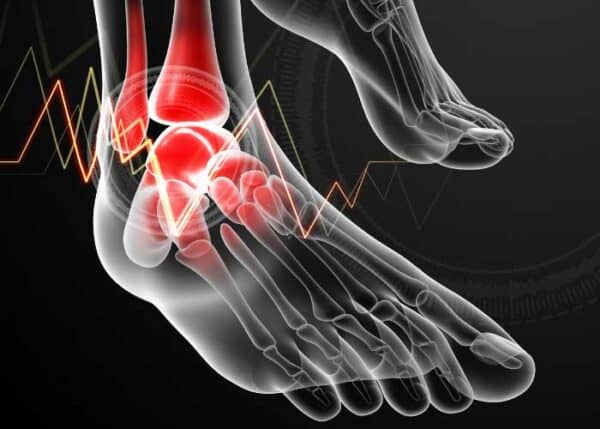Ankle Ligament Tear and High Ankle Sprain Specialists
The posterior inferior tibiofibular ligament (PITFL) and the deltoid ligament are located on the outside and inside of the ankle and are responsible for stabilization. PITFL sprains typically occur with grade III “high” ankle sprains and may also include the deltoid ligament. These injuries, commonly seen in high-level athletes, are challenging to diagnose and require the expertise of a highly skilled orthopedic surgeon for proper treatment. Dr. C. Thomas Haytmanek and Jonathon Backus, MD treat patients from Vail and Frisco, Colorado, as well as Denver, Boulder, and surrounding Summit County areas who have suffered a posterior inferior tibial fibular ligament tear or a deltoid tear. Call our office today!

What are posterior inferior tibial fibular ligament and deltoid tears?
The posterior inferior tibiofibular ligament (PITFL) and the deltoid ligament are located on the outside and inside (respectively) of the ankle and are responsible for stabilization. The PITFL is found in the back of the distal tibiofibular joint, which connects the tibia and fibula just above the ankle. This ligament is part of the syndesmosis ligament complex. The deltoid ligament, also known as the medial ankle ligament, is located on the inner (medial) side of the ankle. Injuries to one or more of these ligaments can significantly impact ankle function and requires an ankle specialist for appropriate diagnosis. Dr. C. Thomas Haytmanek and Dr. Jonathon Backus specialize in treating these types of ankle injuries for patients from Vail and Frisco, Colorado, as well as Denver, Boulder, and surrounding Summit County areas.

What are the bands of the deltoid ligament in the ankle?
The deltoid ligament is a strong, flat, triangular band of connective tissue that connects the tibia to the talus, calcaneus, and navicular. It was the main stabilizer of the medial ankle. This complex ligament is commonly divided into a superficial and deep layer.
The superficial layer provides stability to the naviculocalcaneal complex and resists external rotation of the talus relative to the tibia. The most commonly recognized ligaments of the superficial layer are:
- The tibionavicular ligament (TNL): Part of the deltoid ligament, that connects the malleolus, the bony protrusion on the inside of the ankle, to the tarsal bones of the foot.
- The tibiospring ligament (TSL): Part of the deltoid ligament in the ankle that connects the medial malleolar colliculus to the superomedial spring ligament.
- The tibiocalcaneal ligament (TCL): Part of the deltoid ligament, also known as the medial collateral ligament (MCL)
- The posterior superficial tibiotalar ligament (SPTTL): A ligament in the ankle that runs from the medial tibial malleolus to the talus. It’s located above the deep posterior tibiotalar ligament and behind the tibiocalcaneal ligament.
The deep layer assists in stabilizing the talus and resists posterior translation of the talus, valgus angulation of the talus, and lateral displacement of the talus from the medial malleolus. The deep layer is comprised of:
- The anterior tibiotalar ligament (ATTL): A thin, short ligament that connects the tibia and talus on the medial side of the ankle.
- The posterior tibiotalar ligament (PTTL): It is a broad and thick ligament that connects the medial tibial malleolus to the talus.
What are the symptoms of posterior inferior tibial fibular ligament and deltoid tears?
- Bruising
- Difficulty bearing weight on the injured leg
- Difficulty walking (especially on the toes)
- Tenderness
What can cause a PITFL or a deltoid tear?
PITFL injuries almost never occur in isolation. Isolated deltoid sprains are also rare.
PITFL sprains typically occur with grade III “high” ankle sprains. Often in these high-grade injuries, the deltoid ligament is also torn. Medial (deltoid) ankle sprains can occur in isolation, with “low” ankle sprains, and also with fibular fractures. Deltoid ligament injuries can occur with a significant rotation to the foot externally, which when associated with a fibular shaft fracture is termed a “Maisonneuve Fracture”
These types of injuries occur when the foot is flexed upward and the ankle is twisted (primarily with external rotation of the foot relative to the leg). They usually only occur due to a strong application of force or with an extreme twist. These types of tears or sprains are rare and typically affect athletes who participate in sports like basketball, football, hockey, skiing, snowboarding and soccer.
How are posterior inferior tibial fibular ligament and deltoid tears diagnosed?
An MRI is still the best way to diagnose a posterior inferior tibial fibular ligament and deltoid tears. Acute deltoid ligament complex injuries are categorized as superficial or deep. The level of disruption of the ligament is classified as:
- Grade I: The ligament is stretched, but not torn
- Grade II: The ligament is partially torn, but intact
- Grade III: Complete disruption and tear of the ligament.
What is the treatment for posterior inferior tibiofibular ligament and deltoid tears?
Non-Surgical Treatment:
Acute injuries of the PITFL and Deltoid may benefit from conservative treatment if the injury is determined to be stable by your orthopedic surgeon. This consists of immobilization with a boot or cast followed by physical therapy.
Surgical Treatment:
Surgical treatment will depend on the exact nature of the injury. If ankle instability is an issue, even after internal fixation of an ankle fracture, a lateral ligament stabilization procedure or fixation of a syndesmosis injury, reconstruction or repair of the deltoid ligament may be needed. Our specialists at Sports Foot and Ankle use careful surgical planning and a careful intraoperative algorithm to obtain the best outcomes for each injury pattern.
